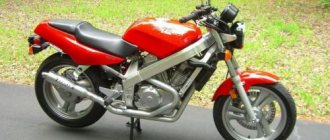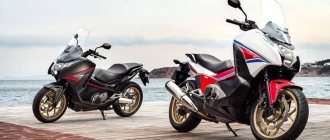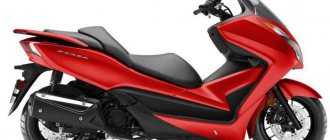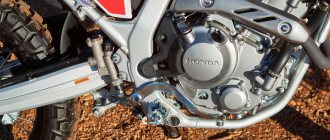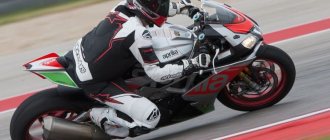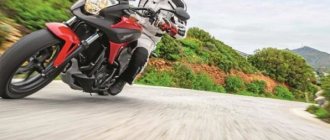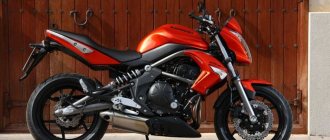General characteristics
General characteristics:
- Engine capacity 249 cm3;
- Tank volume 9.3 liters.;
- Total length 2107 mm;
- Total width 825 mm;
- Total height 1135 mm;
- Wheelbase 1355 mm;
- Ground clearance 240 mm
- Dry weight 123 kg;
- Maximum load 158 kg;
- Cylinder compression 1.569 +-96 kPa (16 +-1 kg/cm2; 228+-14 Psi);
- Compression ratio 10.4:1;
- Generator power 204 W at 5000 rpm;
- Idle speed: 1300 +-100 rpm.
- Intake valve clearance: 0.23 +- 0.03 mm. (cold engine);
- Exhaust valve clearance: 0.23 +- 0.03 mm. (cold engine);
Test drive HondaXR 250 Baja, SuzukiDjebel 250 XC, YamahaTT-R 250
The crisis did not strike like a child. The roads are rapidly deteriorating, gasoline is becoming more expensive, but the traffic jams are not getting any better, and the traffic police are rampant, armed with “Sights” and stationary cameras, the mood is falling, and depression is growing. What to do? How to improve your vitality and save on travel? Lightweight “used” Japanese enduros are the class that, at a minimum cost, can provide maximum functionality, economy and freedom of movement in cramped urban spaces. It was hard to refuse the opportunity to “try on” six representatives of this glorious cohort of “enduro for the start”. And we didn’t refuse!
Honda XL250 Degree II – Yamaha TT250R Raid – Suzuki XC250 Djebel –Honda AX-1 – Honda XLR 250 Baja – Honda XR250 Baja
February is clearly a pre-season month, but one of the advantages of the enduro class is precisely that the season does not have to be closed at all! Therefore, even the snow that fell all day yesterday could not stop the motley group of riders, already tuned to the desired wave.
Despite the fact that at first glance we tested completely different motorcycles, they nevertheless have a lot in common: all of them can be classified as dual-purpose motorcycles (that is, for riding both on asphalt and light off-road); they are all approximately equal in power to their single-cylinder four-valve engines and identical in their displacement; all were produced in the “land of the rising sun”; all fit the role of “the first universal motorcycle”; all fall into the budget price category of the “3 to 5” range.
But these models differ in their geometric parameters, which is important for people of different heights and different off-road experience. The most “soft” is the AX-1, in fact, it is an ideal city motorcycle with a wide range of capabilities. And the most “hard” one – the Honda XLR250 Baja – is quite good for conquering even serious off-road conditions.
The opinion of the “enduro-teapot”
Vladislav Sofonov
Height 180 cm,
weight 75 kg.
Driving experience: 7 years.
Rides a Kawasaki ER-5 Twister.
The world of enduro is very different from the world of other motorcycles, and it is very difficult for an unprepared person to understand all their intricacies and intricacies. Likewise, for me, who almost never encounters such devices in my life, at first it was difficult for me to master a new technique, especially when there were six motorcycles in front of me at once. Six! And everyone is similar to each other. Although, no. One of them somehow stood out from the crowd: alloy wheels and a little more plastic - if it’s an enduro, then some kind of more road-worthy, “SUV”, so to speak... What does it say there? "AH-1". So, I seem to remember one... But how to distinguish all the others? Okay, I thought, I’ll figure it out during the test.
The first to ride was the Honda XR250 Baja. Already in the first seconds of communicating with it, I felt its high torque, available at almost any speed. On solid ground (in this case, asphalt), the motorcycle quickly starts from a standstill, picking up speed at low speeds in jerks, and at high speeds it even tries to lift the front wheel off the ground. The tall silhouette, because of which beginners may be afraid to get on a motorcycle (they say, it will be difficult to touch the ground with your feet - I’ll figure it out later...), in fact it turned out to be not so tall. Indeed, due to the enormous travel of both the front and rear suspensions, when the driver sits down, the motorcycle sags significantly under his weight. The same applied to the other "high" bikes in this group. True, the Baja XLR250, due to its stiffer suspension settings, squatted less under me.
Those who think that enduro is not a motorcycle for asphalt are very mistaken. All test subjects drive on asphalt no worse, and some even better, than on off-road. Even the Baja XLR250, with its knobby tires, allows you to take tight turns at high speed and without the constant “catch” of the motorcycle that is typical of off-road riding. Therefore, for those who are planning to get into enduro and have no experience with such equipment, I advise you to first master it on asphalt, and only then “go into the wilds”.
To imagine what a light enduro is like on complete off-road conditions (and even more so in the mud we had to experience), you can try riding a bike on ice - the sensations will be similar. The rear wheel, shod with universal rubber, continually slips into slippage, during which the motorcycle sometimes rolls. It happens that the front wheel can also become blocked, and only because it is stuck in the mud does the motorcycle not fall on its side for some time. Only the Baja XLR250, with its knobby tread, was able to maintain traction on muddy ground. But for me its “hard” component was a minus. It seemed to me that it has a powerful, sharp engine, the stiffest suspension settings, and the seat is higher than other motorcycles, which is why it was difficult for me, as a beginner, to feel a clear relationship with the road (read: off-road). For example, it is very difficult to predict the moment when the rear wheel of an XLR slips, and after it has drifted 30-40 centimeters to the side, it is difficult to “catch” the motorcycle and straighten its trajectory - to do this, you need to release the gas and turn the steering wheel in the direction of the skid, while remembering to maintain balance. Due to the high seating position, it is more difficult to reach the ground with your feet, and therefore it was sometimes difficult for me to keep this bike upright on washed-out ground.
So I won’t recommend the XLR250 to beginners. The Honda XL250 Degree is more suitable for them. Small and nimble, the Degree handles well on asphalt, soaking up potholes much better than other test participants - although its suspension has less travel, it is much softer. If when driving through holes on other motorcycles you feel dull impacts, then on the Degree only a slight rocking is noticeable. The downside of such a soft suspension can only be the relatively low ground clearance, which in the city is only enough to drive onto a medium-sized curb, although you can jump at a speed without hitting your “belly” at a higher speed. Remarkably, while the Degree didn't have as much off-road ability as the other four higher-end enduros, it was much easier to ride. It has the lowest seat, so you can always easily steer the bike with your feet, but due to the low center of gravity, such assistance is rarely required. First gear on the Degree is very short and should only be used when going up extremely steep hills. In all other cases, it is better to use second gear, even when driving at walking speeds, since in mud the rear wheel in first will skid uselessly, not providing the necessary increase in speed.
The AX-1 really disappointed me on asphalt. At speeds above 90 km/h, its handling deteriorated noticeably. First of all, the steering had inadequate reactions: at the slightest movement of the steering wheel, the front of the motorcycle began to sway from side to side and the feeling of solid contact with the road was lost. Perhaps this nervous behavior was caused by the fact that the motorcycle was slightly tuned (artificially raised) to improve ground clearance, but at the same time the steering geometry was violated. It also didn’t shine on the dirt road, but still held up well thanks to fresh tires, albeit with a universal tread. And although this motorcycle does not belong to the “enduro” class, I take the liberty to say that occasionally you can have fun on light off-road terrain.
The Honda XR250 Baja and Suzuki XC250 Djebel performed approximately equally. Both have the same sharp throttle response and similar performance characteristics. They, like other motorcycles (with the exception, again, of the “toothy” XLR) are poorly suited for driving on washed-out off-road conditions, since their standard tires, intended more for asphalt and dry primers, quickly become clogged with dirt, turning into a kind of “slick”. But the high ground clearance allows them to storm even high obstacles (for example, logs) without fear of hitting them with their “belly.” I’m not even talking about ordinary city curbs - driving onto any of them on XR, XLR, Raid and Djebel is a piece of cake. Moreover, you can drive into low ones even at an acute angle, the main thing is to hold the steering wheel tightly and the large 21-inch wheel will easily overcome such an obstacle.
I was already familiar with the Yamaha TT250R Raid, and therefore this test only provided an opportunity to compare it with other similar motorcycles. The Raid performed no worse than the others, except that the response of its engine was softer and more elastic. It does not have the sharpness that is observed in the XR, XLR and Djebel - at low speeds it does not take off, but at high speeds it is not inferior to other test participants. Thanks to this nature of the engine, it is possible to drive through difficult places “tightly”, maintaining good contact of the rear wheel with the ground and preventing uncontrolled slipping. With such a motor, the driver’s relationship with the road is significantly improved. And since it is almost as good as the Baja and Djebel in terms of ground clearance and suspension travel, you can cast your vote in favor of one motorcycle or another only based on personal feelings. And if I had to choose an enduro as a “zero option”, then of all the motorcycles I tested, I would (at this stage of my acquaintance with them) choose the Raid. Although a person with a different height and temperament will easily make a different choice, especially if this motorcycle is the only one he has.
Opinion of the “advanced”:
Igor Shchelkunov
Height 176 cm,
weight 74 kg.
Driving experience: 15 years.
Rides a Yamaha XT660R.
I’ve long wanted to try a lightweight enduric, but then they offered me six pieces at once. Visually, I liked the Honda Degree the most. Modern design, cheerful colors, liquid cooling. Although all the bikes (except the AX-1) were from the mid-90s, the Degree looked like the freshest of them all. I was struck by the similarity between Yamaha and Suzuki. Even the wheels are the same, unusual purple color. The most advanced tidy is on Suzuki. Completely digital, there is a lot of information on it - even by today's standards it looks like an adult. On Honda (and almost all of them), on the contrary, everything is spartan (only the XR250 Baja also sported a digital tidy). The Honda XLR250 Baja looked the angriest of all (as it turned out later, it didn’t just look...). All motorcycles, except the “evil” XLR, are started with an electric starter.
The first stage of the test is driving along the highway to the place of off-road rides. All participants confidently reached 110 km/h. There was still some reserve, but I didn’t want to test the “maximum speed”; that’s not what these motorcycles were made for. While driving along the highway, I noticed one peculiarity. The pants I was wearing were textile, made of cordura fabric. And on all motorcycles (except Yamaha Raid) I slid on the seat as if on ice. But everyone who was wearing leather did not feel the difference. I liked the AX-1 on asphalt. In terms of ergonomics, it is very similar to a classic motorcycle, only it handles better.
On off-road, a lot depends on the tires. And even the more asphalt AX-1 on cast wheels felt good even on muddy ground thanks to fairly grippy tires. Unfortunately, it was not possible to fully test the off-road qualities of the Suzuki Djebel: it was shod with road tires and the slightest attempt to “mix the dirt” ended in either slipping or blocking of the wheels. On the Yamaha Raid I liked the wider handlebar (although it was a tuning one). When actively driving along the “intersection”, you don’t get tired so quickly with it. But in cramped city conditions, I wish the steering wheel was a little narrower. As expected, the Honda XLR250 Baja turned out to be the most aggressive off-road. Its highest ground clearance and considerable suspension travel, combined with the lightest weight, toothy tires and a fairly powerful engine, allow you to choose any direction, regardless of the quality of their surface. But all this comes at the price of a slightly narrower seat and a kick instead of an electric starter. The pleasant rustling of the engine and soft, almost imperceptible gear shifting pleased the components of all Hondas.
I liked the Yamaha Raid in the city. Average height, moderately stiff suspension, fairly wide seat, high-torque and playful engine. After the XT660R, which I ride, the first thing that pleased me was the light weight of this bike. Minus 40-60 kg is simply a salvation when driving slowly through traffic jams and on muddy ground. For people with little muscle mass, this is a definite plus! Any city obstacles in the form of edges, steps and speed bumps can be passed effortlessly on all motorcycles. The power and speed of any 250 are quite enough for active driving (without a passenger). Fuel consumption is also good. We drove for half a day on 3 liters of 92 gasoline, including off-road, and still had some fuel left.
Perhaps this is the most budget and universal (city, short trips, off-road) offer on the Ukrainian market today. If we also take into account the quality of our roads, then these models should be the most popular in our country. I was surprised by the technical condition of all the motorcycles. Despite the age from 8 to 20 years, everyone had the “sit down and go” status.
The motorcycles in the presented group are, of course, multi-purpose in essence. But if you plan to drive more around the city, I advise you to take a closer look at the Honda AX-1 and Honda Degree. If it’s 50:50, then go to the Yamaha TT250R or Suzuki Djebel. Well, if you are a fan of off-road raids, then your motorcycle is the Honda XR250 Baja or, even better, the XLR250 Baja.
Alexander Buluy
Height 190 cm, weight 85 kg.
Driving experience: 10 years.
Rides: Yamaha XTZ750 Super Tenere
In general, the impression of these motorcycles is completely positive. Their common feature: due to their low weight and high “agility”, you immediately want to “tweak” them.
The first thing that impresses you when you get on these motorcycles is how easy it is to control. She's literally a biker! Only these “bicycles” have engines, and even a volume of 250 cm3. These two factors give them a big advantage. They can be safely recommended to novice motorcyclists and motorcyclists. Outwardly, these “lightweights” are very similar to each other. But still there are significant differences, both in geometric parameters and in the design and nature of the motors.
The Honda Degree II seemed the cutest to me. In my opinion, it can be considered a universal urban enduro. She is not high on the saddle and the motor spins very happily. And if you want to “go crazy”, then it’s not a problem – it won’t let you down on soil of any density. The next place is occupied by the Honda AX-1 with the same engine. But you have to be more careful with it in off-road - the wheels are alloy, and the wheels are small: the rear is 16" and the front is 19".
The rest of the motorcycles occupy deeper places off-road. Their suspensions are longer-travel, the wheels are spoked, the correct protection is installed wherever necessary and everything is already from the factory (even on the headlight), which you won’t find on modern endurics during the day. Air-cooled motors have long proven themselves in off-roading as “unkillable”. In this group, I would especially like to highlight the Yamaha TT250R Rally Raid. Her motor seemed the most playful of the whole group. A wide, comfortable seat and a large gas tank will make it possible to cover at least three hundred kilometers without stopping. Both Honda Bajas have a layout closer to a cross-country vehicle, and the engines have an even traction pattern. Suzuki Djebel is somewhat similar to the TTR, in every way. Who copied whom? For the Japanese, this is a normal phenomenon: to make the same thing, only better. It’s a pity that we weren’t able to fully test the Suzu off-road because of the asphalt tires. But on other hard surfaces he behaved quite decently.
Pavel Kostyuk
Height 175cm, weight 78kg.
Driving experience: 12 years.
Rides: Yamaha XTZ660 Tenere and XT660R
What is "250"? First of all, this is ease of operation, and therefore, such a device is universal for both training and extreme sports. The presented motorcycles can be described something like this. Very different from the rest of the AX-1: its compactness, small-diameter cast wheels and limited capabilities (as well as softness) of the suspension classify it as an urban enduro, or fanduro. But... with good opportunities to ride off the asphalt on hard dirt roads and forest paths. The engine amazes with the liveliness of its character, the only significant drawback is the soft suspension.
The most recent of all (in terms of condition) is the second generation Honda Degree. Such an elegant and dapper motorcycle that it was a pity to even get it dirty. But it’s okay, we quickly fixed it. Its low height on the saddle allows you to do all sorts of tricks in the mud without fear of falling off. The motor is as good as the AX-1, which is not surprising - one design. In terms of landing, both cars are clearly ideal for short pilots.
And here are two more Hondas. The two Bajas look very similar at first glance. But an electric starter is not a luxury at all: it stalls, presses a button and saves energy. The XLR model only offers kick, but it is the lightest among these 250-k. Although it is the kick that most closely connects the rider with the motorcycle. Both engines are Honda-style obedient and calm, but on the XLR it still seems brighter and more driving. It is quite possible that due to the slightly closer first three stages of the box. The suspensions of both absorb bumps of any size without any problems. You can generally storm the edges at 60 km/h. The devices are high on the saddle and it will be difficult for a beginner at first.
Djebel and TTR are very similar in character. But when you sit on a Yamaha, you feel something familiar. The gearbox works a little harshly, but the chassis and engine are somehow correctly designed for drive. Or maybe it's a habit?
On the Djebel, the gearbox seems vague (probably after the Honda), and maybe the age of the motorcycle is taking its toll. The engine clearly asks for higher revs, so it happily responds to the throttle.
The motorcycles each showed their characters in their own way. Both Bajas performed well off-road, but proved unstable at speeds exceeding 100 km/h. Still, the spirit of enduro dominates in them. The AX-1 makes it clear that it's more about city streets. Degree, due to the liveliness of the engine, does not lag behind anyone, either on the ground or on the asphalt. The most versatile in city/off-road use were the Yamaha TTR and Suzuki Djebel.
Valery Chuikov
Height 186 cm,
weight 120 kg.
Driving experience: 28 years.
Rides a Suzuki V-Strom DL1000
I was happy to try all the motorcycles presented in the test off-road (since I had ridden many of them on asphalt before, except for the Suzuki Djebel). I’ll be honest, I didn’t expect such high cross-country ability from everyone! Even the “parquet”-looking AX-1 held up well on its universal tires and, if not for the more “revving” engine and smaller wheel diameter, would have kept up with the Degree. By the way, during this test I first tried the very rare Degree II, even for Japan, which differs from the same first-generation model in the rear disc brake (instead of a drum brake) and a different design. And I liked it no less than its predecessor, and about the “dropsy” of this trinity they generally say that this is an “eternal” motor - there is a lot of evidence of this!
Perhaps I can state that these two motorcycles (AX-1 and Degree of both generations) are ideal for those who have “zero” experience in riding a motorcycle and are looking for their first, most versatile bike with a suburban-urban mode of use. But the other four test participants can give a lot of pleasant sensations to experienced motorcyclists without extensive off-road experience (or none at all). I would rank them in terms of off-road capability: the XLR250 Baja is the most “advanced” device in this regard. Next comes the younger Baja “number two” (especially good because you can pleasantly drive hundreds of kilometers to the place of off-road rides). Raid occupies the “golden” mean and is as good as possible in both elements, but Djebel is perhaps the only one with the most powerful and very durable engine and touring qualities (at the “for two” level), but on asphalt tires and looking, let’s say, not bad off-road, provided that it is re-shoeed with “hard” off-road tires.
Text: Vlad Sofonov, Valera DRIVE
Comments: Igor Shchelkunov, Alexander Buluy, Pavel Kostyuk
Photo: Andrey Shlenchak
Engine oil and oil filter
Required engine oil volume:
- 1.3 liters of oil without filter replacement;
- 1.32 liters of oil with filter replacement;
- 1.6 liters of oil after complete disassembly of the engine.
Original engine oil filter:
- 15412-KF0-000
- 15412-KF0-010
- 15412-KF0-020
- 15410-KF0-305
- 15410-KF0-315
Engine oil filter analogues:
- Mann MH53
- HifloFiltro HF112
Tightening torques:
- Drain bolt 25 Nm;
- Oil filter cover bolts 12 Nm.
Review of Motorcycle Honda XL250 Degree, Quite a rare and interesting device
Honda xl 250 degree 2
Diablero
: Hello, dear forum members! Now I’m in the process of buying a motorcycle at a Japanese auction, initially I was targeting a Honda ax-1, but recently I discovered another interesting Degree2 model (as I understand it, the rear brake is disc). I want to ask you for advice. How does it compare to the ax-1? Can it be considered as an alternative? The wheels seem to be more standard in size and spoked, the engine is awesome, which is good news. But maybe there are downsides? I'm going to drive on asphalt to get to work and off-road for recreation, about 50/50.
griggs
: Digri is a real endura, only a small one. I myself dream of taking it for the pampas, the disadvantages are like for all internal Japanese, some spare parts are difficult to get, but it’s a good motorcycle.
Jibs
: Yes, it is even less common than AX. This is the main problem. Let's say on ebay, what the hell can you find on degriha. The motor is slightly different in terms of settings. More grassroots. (I could be wrong). And this is a great option.
Diablero
: Thanks for the info. Can you tell us anything about the Kawasaki Super Sherpa KL250? It also falls into this price category.
Jibs
: Sherpa is considered a “mountain” motik. Low in the saddle, with short gears. The air motor is less playful than the AKS.
Diablero
: I see, then I won’t consider it. So, it’s decided, I’ll take the AKS! Thank you for helping me get rid of my doubts.
Diablero
: The topic should have been called “help me decide”)) I have another question about the modifications of the ahi, how critical is the function of preloading the rear shock absorber and the modified gas distribution for working at the bottom? Has anyone compared? There really is a difference in traction, for example. Just, I'm watching the auction and maybe a model in md21-10 in good condition will appear. Should I wait for md21-11?
Jibs
: Personally, I like the “second” modification better because you can (or rather will have to) tighten the shock absorbers (not the collective farm spacers) and use a symmetrical tidy. I haven't heard of modified valve timing.

